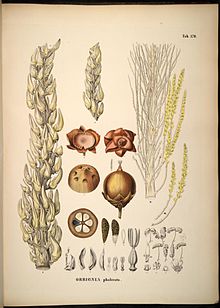Orbignya phalerata
| Babassu | |
|---|---|
 |
|
| Scientific classification | |
| Kingdom: | Plantae |
| (unranked): | Angiosperms |
| (unranked): | Monocots |
| (unranked): | Commelinids |
| Order: | Arecales |
| Family: | Arecaceae |
| Subfamily: | Arecoideae |
| Tribe: | Cocoseae |
| Subtribe: | Attaleinae |
| Genus: | Attalea |
| Species: | A. speciosa |
| Binomial name | |
|
Attalea speciosa Mart. |
|
| Synonyms | |
|
Orbignya phalerata |
|
Orbignya phalerata
Orbignya martiana Barb.Rodr.
Orbygnia speciosa (Mart. ex Spreng.) Barb.Rodr.
Attalea speciosa (babassu, babassu palm, babaçu, cusi) is a palm native to the Amazon Rainforest region in South America. The babassu palm is the predominant species in the Maranhão Babaçu forests of Maranhão and Piauí states.
This plant has commercial value because its seeds produce an edible oil called babassu oil, which is also used in cleaners and skin care products. The fruit is used to produce products such as medicines, beauty aids, and beverages. Traditional communities of the Maranhão region also produce a flour from the fruit and this is commercialized as a nutritional supplement. The leaves are also used to provide thatch for houses and can be woven into mats for constructing house walls. The stems are used for timbers. The Babassu palm is considered a weed in pasture areas of Cerrado vegetation in Brazil.
Its fruits and leaves are one of the main materials used by the artisans of (Brazil) to manufacture different products very popular with tourists.
In his 1995 The Palms of the Amazon, Andrew Henderson recognised A. speciosa and A. spectabilis as valid species, but considered the latter to either be an acaulescent form of A. speciosa or a hybrid between it and A. microcarpa. In their 2005 World Checklist of Palms Rafäel Govaerts and John Dransfield accepted A. spectabilisas a valid taxon but Sidney F Glassman considered it a dubious taxon in his 1999 Taxonomic Treatment of Palm Subtribe Attaleinae. Attalea vitrivir was recognised as a distinct species by Michael Balick and coauthors; Glassman and Govaerts and Dransfield concurred, but Henderson considered it part of A. speciosa. Glassman also described a fourth member of this group, A. brejinhoensis, and it is accepted by Govaerts and Dransfield.
...
Wikipedia
